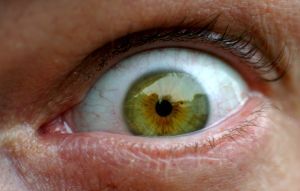Although he was a star hockey player during his college years, John didn’t make the pros. He moved his trophies into the family room of the townhouse he and his wife Elaine bought soon after their marriage and knocked around a puck with a few friends from time to time. At the age of 26, however, he discovered his college hockey days had left him with something new: sympathetic ophthalmia.
Overview
According to Merck, sympathetic ophthalmia is an inflammation of the eye’s uveal tract. The uvea is the pigmented middle part of the eye, including the iris, ciliary body and choroid. This inflammation occurs after an eye trauma or surgery.
Experts estimate the condition happens with up to 0.5 percent of nonsurgical and less than 0.1 percent of surgical penetrating eye wounds. What makes it so rare is that is occurs in the unaffected eye and sometimes years after an individual experienced an injury or had an operation on the other eye. While some symptoms have appeared only a week after the precipitating event, others have surfaced decades later.
The American Uveitis Society reports that the term sympathetic ophthalmia surfaced in 1840. Hippocrates was familiar with the condition more than 2,000 years ago. Doctors have reported a case that occurred 66 years after the injury in the opposite eye. However, the disorder strikes 90 percent of its victims within the first year.
Research currently focuses on finding the best treatments to preserve sight and prevent recurring attacks.
Cause
Unfortunately, medical experts don’t completely understand the cause of sympathetic ophthalmia. The most common belief is that it’s the result of an attack by the immune system on specific parts of the eye tissue. Some believe certain germs or microorganisms might be culprits.
Symptoms and Diagnosis
John’s case was typical as far as his symptoms. He first noticed a few floaters. His visual field gradually became darker. What finally sent him to an ophthalmologist was detachment of the retina in the eye the hockey puck had missed during a practice.
By the time they see a health care provider, patients typically have noticed blurry vision and complain of pain in both eyes. The ophthalmologist who examines them usually notes red and painful eyes and a swollen middle layer of the eye that wasn’t injured or the target of surgery.
There are no specific tests that prove whether a patient has sympathetic ophthalmia. Doctors make the diagnosis based on a complete medical history and careful medical exam. If the patient reports a history of an injury to or surgery on one eye and has inflammation in both eyes, the condition might be present.
Vision testing includes the use of special instruments that measure eye pressure and magnify dilated eyes under bright light. In some cases, ophthalmologists also use ultrasound. Blood tests and a chest X-ray can rule out other diseases with similar symptoms.
Treatment and Prognosis
Without prompt and correct diagnosis and treatment, sympathetic ophthalmia can result in a poor prognosis for the patient’s vision. Individuals who are quickly treated are likely to retain a useful level of vision. The condition is not classified as a blinding disease.
The primary treatment is the prompt administration of significant doses corticosteroids to control inflammation. If the required dosage is so high that it can only be administered through an IV, the patient usually receives it in the hospital.
Doctors consider sympathetic ophthalmia difficult to treat. Some patients will require additional therapy such as the use of immunosuppressive medications to try to save their vision.
Sources:
Merck site
American Uveitis Society site
Reference:
- Merck site
- American Uveitis Society site






